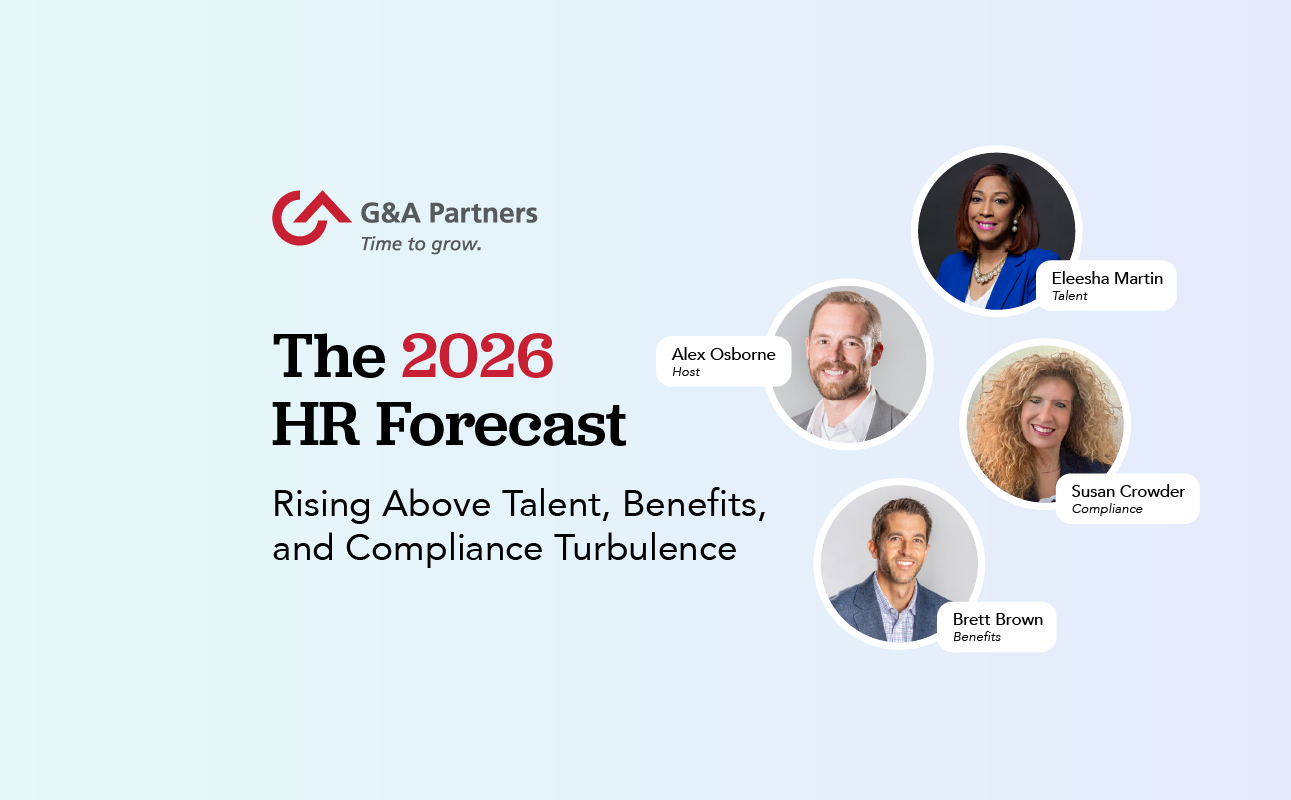
Year-end is a great time for employers to help their team learn how to maximize employee benefits by taking full advantage of programs and offerings that support their financial security and well-being—including 401(k) savings, HSA (health savings account) and FSA (flexible spending account) contributions, and paid time off usage.
A few timely reminders and simple educational touchpoints can help your team make informed choices—whether that means contributing more to tax-advantaged accounts like an HSA, spending down FSA balances before they expire, or using earned time off to recharge before the new year.
When you take a proactive approach, both your team and your organization benefit. These efforts not only improve participation and satisfaction but also give you valuable insight into how benefits are being used—helping you refine future offerings, reduce administrative backlogs, ensure compliance, and set the stage for a more organized start to the new year.
In this article, we’ll share practical ways to help employees make the most of their 401(k), HSA, FSA, and PTO benefits—from boosting awareness and communication to streamlining processes through HR technology and PEO (professional employer organization) support.
Why Year-End Planning for Employee Benefits Matters
Every year, employees leave value on the table—whether it’s unused PTO, unclaimed FSA dollars, or missed 401(k) contribution opportunities. And while these may seem like minor oversights, they can have a significant impact on financial security, well-being, and overall job satisfaction.
That’s where thoughtful guidance from HR and leadership makes a difference. When you take the time to educate your team and share timely reminders, you’re showing that you care about their long-term success. These simple actions can increase participation and help your organization get more value from the benefits you offer.
And while greater participation may mean processing a few more PTO requests or matching higher 401(k) contributions, the return is well worth it. When your team feels supported to make the most of their year-end employee benefits, they’re more engaged, motivated, and connected to your company’s success—and you gain valuable insight into which programs they truly value.
2025–2026 Quick Reference: Employer Year-End Benefits Deadlines
To help stay on top of year-end responsibilities, the chart below provides a quick reference for typical benefits and payroll deadlines.
Sharing these reminders early gives your team time to act—whether that means adjusting 401(k) contributions, using available PTO, or making final HSA deposits. Keeping these dates visible also helps reduce last-minute stress for HR and payroll as the year wraps up.
Suggested Timeline |
Benefit/Area |
Employer Responsibility |
Employee Action Needed |
November 1 - December 15, 2025 |
Open enrollment for plans renewing in January |
Finalize benefits offerings, distribute enrollment information, and ensure employees submit elections. |
Complete benefits elections for 2026 (health, dental, vision, ancillary plans). |
November 1 -December 31, 2025 |
PTO/vacation |
Remind employees of “use-it-or-lose-it” or rollover rules and update accrual balances for the next year. |
Use remaining PTO (if not eligible for rollover). |
December 15, 2025 |
Payroll and bonuses |
Run final bonus payrolls for 2025 inclusion. |
Confirm direct deposit information and review pay stubs. |
December 31, 2025 |
401(k) contributions |
Ensure employee payroll deductions are processed for year-end. |
Make final contributions to reach the annual IRS limit—$23,500 (under age 50) or $31,000 (age 50+). |
December 31, 2025 |
FSA spending deadline* |
Communicate deadlines, process claims, and clarify grace-period or carryover options. |
Spend down FSA balance unless grace period or carryover applies. |
January 15, 2026 |
Final payroll filing for 2025 |
Submit final 2025 withholdings, taxes, and retirement contributions. |
N/A |
January 31, 2026 |
Tax forms (W-2 and 1099) |
Distribute forms to employees and independent contractors. |
Review for accuracy and retain for tax filing. |
April 15, 2026 |
HSA contribution deadline |
Remind employees they can contribute for 2025 HSA through Tax Day. |
Make final 2025 contributions to HSA. |
*While the 2025 FSA deadline for spending is December 31, 2025, employers may offer a 2.5-month grace period (through March 15, 2026), or a carryover of up to $660 (IRS 2025 limit, subject to change). Be sure to clarify which option applies to your plan.
Step 1: Maximize 401(k) Contributions Before Year-End
The 401(k) contribution deadline for 2025 is December 31, and any contributions made after that date won’t count toward the 2025 tax year. Encourage your employees to review their contribution levels well before the deadline—especially those nearing the annual IRS limit or those eligible for catch-up contributions if they’re 50 or older.
Helping employees understand how to maximize employee benefits through their retirement plan supports long-term financial wellness and ensures they take full advantage of your company’s match program.
You can make this process easier and more engaging with a few simple steps:
- Send automated payroll reminders in early December to flag the deadline.
- Share quick “how-to” guides for the adjusting contribution rate.
- Highlight the impact of employer matching.
Before closing out the year, double-check that all payroll deductions are processed correctly and any last-minute changes have been captured. Staying proactive helps you avoid reconciliation issues in January and sets up your team and HR systems for a smooth start to 2026.
Step 2: Fully Fund Health Savings Accounts (HSAs)
A health savings account (HSA) is one of the most flexible, tax-efficient benefits available—yet many employees don’t take full advantage of it. HSA contributions are tax-deductible, withdrawals for qualified medical expenses are tax-free, and unlike FSAs, unused funds roll over from year to year—making HSAs a valuable long-term savings tool.
For 2025, the HSA contribution limits for employees enrolled in a high-deductible health plan (HDHP) are $4,300 for individuals and $8,550 for families, with an additional $1,000 catch-up contribution available for those aged 55 or older. While the HSA contribution deadline for 2025 is on April 15, 2026, encouraging employees to contribute before year-end is a great way to help them max HSA contributions and avoid a last-minute rush.
Here are a few practical HSA year-end tips to help employees make the most of this benefit:
- Send targeted reminders to employees enrolled in HDHPs.
- Share educational resources on how HSAs reduce taxable income and build long-term savings.
- Use HR technology to track contribution levels and generate usage reports.
If your organization also contributes to employee HSAs, be sure those deposits are processed before December 31 to ensure they’re correctly applied to the 2025 tax year.

Step 3: Encourage Employees to Use or Plan PTO, Floating Holidays, and Volunteer Time Off
Paid time off (PTO) is a valuable but often underused employee benefit. And with policies varying from “use-it-to-lose-it” to limited rollover, employees are sometimes unclear of their company’s rules. Year-end is a good time for your HR team and managers to audit PTO balances and remind employees of upcoming expiration dates or carryover limits.
Taking time away from work is beneficial for your employees and organization. Regular breaks help prevent burnout, boost morale, and support long-term retention—making PTO planning an essential part of your overall engagement strategy.
Here are a few PTO planning tips to help your employees maximize PTO or vacation days:
- Review floating holidays and volunteer time off (VTO). These hours are easy to forget and often don’t carry over into the new year.
- Encourage managers to coordinate schedules early so team members can recharge before year-end without disrupting business needs.
- Remind staff of company-observed holidays—such as Thanksgiving, Christmas, and New Year’s—to avoid time off requests on days when PTO is not needed. Clear communication prevents scheduling conflicts and ensures fair workload distribution.
- Use your HR time-tracking software to simplify time-off tracking, automate reminders, simplify approvals, and maintain visibility into team availability.
Step 4: Communicate Benefits Clearly
Even the most generous benefits programs can go unused, or underused, if team members don’t understand how they work or what actions to take. Clear, consistent communication helps employees make informed decisions and ensures they don’t miss key year-end opportunities to adjust contributions, spend remaining funds, or use time off.
Here are a few employee benefits communication best practices to support your efforts:
- Use multiple channels: Share updates through email, chat, newsletters, in-office video monitors, or team meetings to reach employees wherever they work.
- Keep it simple: Create short guides, one-page overviews, or FAQs for tasks like viewing PTO balances, changing 401(k) deductions, or submitting FSA claims.
- Incorporate visual resources: Use short videos, infographics, or dashboard screenshots to highlight key steps and deadlines.
- Reach out personally: Encourage managers to follow up one-on-one with reminders and to make it easy for team members to ask questions, get support, or express any concerns.
When employees understand the “why” behind year-end benefits actions—how these steps protect their finances, reduce stress, or help them plan for the year ahead—they’re more likely to participate. Making communication easy, accessible, and relevant builds trust and helps your organization get the most value from its year-end employee benefits programs.
Step 5: Use HR Technology or a PEO to Simplify Year-End Benefits
Manually managing multiple benefits offerings, contribution deadlines, and compliance requirements (especially at year-end) can be time-consuming and overwhelming—even for the most experienced HR teams. The right tools and partnerships can make all the difference.
With modern HR technology for benefits management—in-house or through a professional employer organization (PEO), you can:
- Automate reminders for contribution deadlines, PTO usage, and compliance tasks.
- Consolidate benefits dashboards so employees can view PTO, 401(k), HSA and FSA contributions, and balances all in one place.
- Generate reports to track benefits utilization trends and provide actionable insights to leadership and payroll teams.
- Ensure compliance with updated IRS and state labor requirements.
A trusted PEO partner like G&A Partners can also help manage year-end benefits administration—from payroll tax filings to ACA reporting—while keeping your systems integrated and up to date. With the right technology and expert support, your HR team can reduce manual work, improve accuracy, and spend more time focusing on strategy and employee engagement.
Checklist for Employers Before Year-End
A well-organized year-end checklist helps you stay ahead of key HR, payroll, benefits, and compliance deadlines—so nothing slips through the cracks. You can use it to confirm that your employee records, compliance and tax filings, and year-end employee benefits reporting are complete before the new year begins.
Explore G&A’s Year-End HR Checklist: 10 Steps Every Business Owner Should Take for a practical, step-by-step guide to closing out 2025 and starting 2026 on the right foot.
Start the New Year Strong with Smarter Benefits Planning
Year-end employee benefits planning sets the tone for the year ahead. Encouraging employees to take full advantage of their benefits strengthens engagement, enhances financial wellness, and builds trust between your organization and your people.
By combining proactive communication, technology-driven tracking, and expert HR support, your business can close out the year smoothly and start the next one even stronger.
How G&A Can Help
Connect with G&A Partners today to learn how to maximize employee benefits across your organization. Our HR and payroll solutions help simplify benefits administration, streamline compliance, and give your employees the tools they need to make the most of every opportunity.




